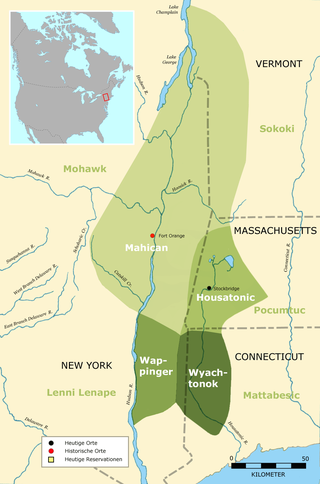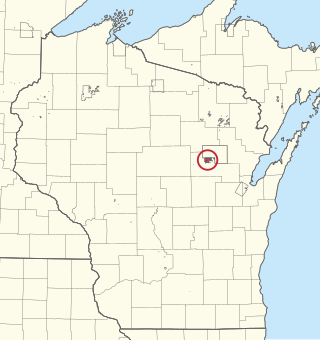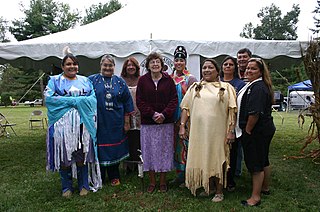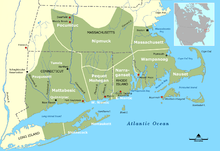
The Mohican are an Eastern Algonquian Native American tribe that historically spoke an Algonquian language. As part of the Eastern Algonquian family of tribes, they are related to the neighboring Lenape, whose indigenous territory was to the south as far as the Atlantic coast. The Mohican lived in the upper tidal Hudson River Valley, including the confluence of the Mohawk River and into western New England centered on the upper Housatonic River watershed. After 1680, due to conflicts with the powerful Mohawk to the west during the Beaver Wars, many were driven southeastward across the present-day Massachusetts western border and the Taconic Mountains to Berkshire County around Stockbridge, Massachusetts.

Quiripi was an Algonquian language formerly spoken by the indigenous people of southwestern Connecticut and central Long Island, including the Quinnipiac, Unquachog, Mattabessett, Podunk, Tunxis, and Paugussett. It has been effectively extinct since the end of the 19th century, although Frank T. Siebert, Jr., was able to record a few Unquachog words from an elderly woman in 1932.

Wawyachtonoc were an Algonquian-speaking Native American people indigenous to east central New York and northwest Connecticut.
The Avoyel or Avoyelles were a small Native American tribe who at the time of European contact inhabited land near the mouth of the Red River at its confluence with the Atchafalaya River near present-day Marksville, Louisiana. Also called variously Shi'xkaltī'ni in Tunican and Tassenocogoula, Tassenogoula, Toux Enongogoula, and Tasånåk Okla in the Mobilian trade language; all names are said by early French chroniclers to mean either "Flint People" or "People of the Rocks". This is thought to either reflect their active trading of flint for tools from local sources on their land in the eponymously named modern Avoyelles Parish or more likely as their status as middlemen in trading flint from Caddoan peoples to their north to the stone deficit Atakapa and Chitimacha peoples of the Gulf Coast.
The Siwanoy were an Indigenous American band of Munsee-speaking people, who lived in Long Island Sound along the coasts of what are now The Bronx, Westchester County, New York, and Fairfield County, Connecticut. They were one of the western bands of the Wappinger Confederacy. By 1640, their territory (Wykagyl) extended from Hell Gate to Norwalk, Connecticut, and as far inland as White Plains; it became hotly contested between Dutch and English colonial interests.

The Christian Munsee are a group of Lenape, an Indigenous people in the United States, that primarily speak Munsee and have converted to Christianity, following the teachings of Moravian missionaries. The Christian Munsee are also known as the Moravian Munsee or the Moravian Indians, the Moravian Christian Indians or, in context, simply the Christian Indians. As the Moravian Church transferred some of their missions to other Christian denominations, such as the Methodists, Christian Munsee today belong to the Moravian Church, Methodist Church, United Church of Canada, among other Christian denominations.

The Wappinger were an Eastern Algonquian Munsee-speaking Native American people from what is now southern New York and western Connecticut.

The Stockbridge–Munsee Community also known as the Mohican Nation Stockbridge–Munsee Band is a federally recognized Native American tribe formed in the late eighteenth century from communities of so-called "praying Indians", descended from Christianized members of two distinct groups: Mohicans and Wappinger from the praying town of Stockbridge, Massachusetts, and Munsees, from the area where present-day New York, Pennsylvania and New Jersey meet. Their land-base, the Stockbridge–Munsee Indian Reservation, consists of a checkerboard of 24.03 square miles (62.2 km2) in the towns of Bartelme and Red Springs in Shawano County, Wisconsin. Among their enterprises is the North Star Mohican Resort and Casino.
The Mohegan are an Algonquian Native American tribe historically based in present-day Connecticut. Today the majority of the people are associated with the Mohegan Indian Tribe, a federally recognized tribe living on a reservation in the eastern upper Thames River valley of south-central Connecticut. It is one of two federally recognized tribes in the state, the other being the Mashantucket Pequot, whose reservation is in Ledyard, Connecticut. There are also three state-recognized tribes: the Schaghticoke, Paugusett, and Eastern Pequot.
The Acolapissa were a small tribe of Native Americans of North America, who lived in the Southeast of what is the present-day United States. They lived along the banks of the Pearl River, between present-day Louisiana and Mississippi. They are believed to have spoken a Muskogean language, closely related to the Choctaw and Chickasaw spoken by other Southeast tribes of the Muskogean family.

The Nottoway are an Iroquoian Native American tribe in Virginia. The Nottoway spoke a Nottoway language in the Iroquoian language family.

The Ofo language was a language spoken by the Ofo people, also called theMosopelea, in what is now Ohio, along the Ohio River, until about 1673. The tribe moved south along the Mississippi River to Mississippi, near the Natchez people, and then to Louisiana, settling near the Tunica.
Mohican is a language of the Eastern Algonquian subgroup of the Algonquian language family, itself a member of the Algic language family. It was spoken in the territory of present-day eastern New York state and Vermont by the Mohican people but is believed to have gone extinct for seven decades. However, since the late 2010s, the language is being revived, with adults learning the language, and children being raised having Mohican as their first language.
The Honniasont were a little-known indigenous people of North America originally from eastern Ohio, western Pennsylvania and West Virginia. They appear to have inhabited the upper Ohio River valley, above Louisville, Kentucky.

The Stockbridge Militia was a Native American military unit from Stockbridge, Massachusetts which served in the Continental Army during the American Revolutionary War. The militia unit was composed mostly of Mohican, Wappinger, and Munsee from the Stockbridge area. While most northeastern tribes, such as Joseph Brant's Mohawks, aligned themselves with the British, the Stockbridge tribes allied with the American Patriots. Led by Jehoiaikim Mtohksin and Abraham Nimham, they were the first group of Native Americans to fight for the cause of American independence during the Revolutionary War.

The Esopus was a tribe of Lenape (Delaware) Native Americans who were native to the Catskill Mountains of what is now Upstate New York. Their lands included modern-day Ulster and Sullivan counties.

Massaco was a native settlement near the present-day towns of Simsbury and Canton along the banks of the Farmington River. The small, local Algonquian-speaking Indians who lived there in the 17th and early 18th centuries belonged to the Tunxis, a Wappinger people.

Indian Mills, formerly known as Brotherton, is an unincorporated community located within Shamong Township in Burlington County, New Jersey, United States. It was the site of Brotherton Indian Reservation, the only Indian reservation in New Jersey and the first in America, founded for the Lenni Lenape tribe, some of whom were native to New Jersey's Washington Valley.

The Munsee are a subtribe and one of the three divisions of the Lenape. Historically, they lived along the upper portion of the Delaware River, the Minisink, and the adjacent country in New York, New Jersey, and Pennsylvania. They were prominent in the early history of New York and New Jersey, being among the first Indigenous peoples of that region to encounter European colonizers.

The Hammonasset people were Eastern Woodland Indians who had their "digging grounds" from the west bank of the Connecticut River to the Hammonasset River in Connecticut.















